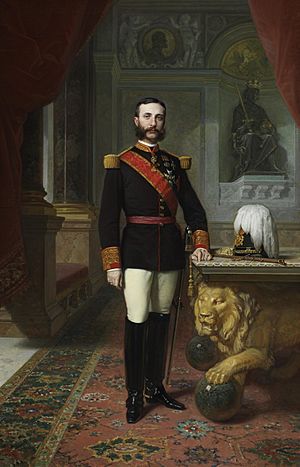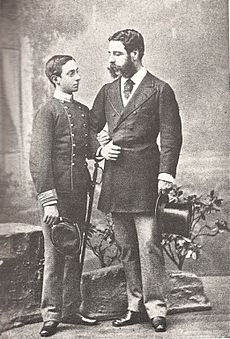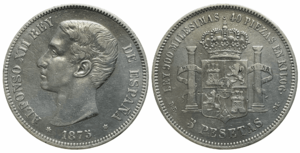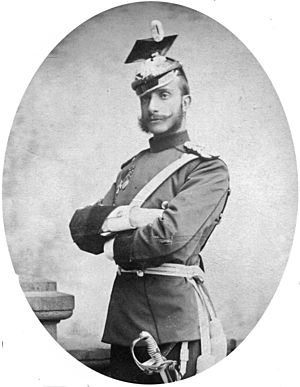Alfonso XII facts for kids
Quick facts for kids Alfonso XII |
|
|---|---|

Portrait by Federico Madrazo, c. 1880s
|
|
| King of Spain (more...) | |
| Reign | 29 December 1874 – 25 November 1885 |
| Predecessor | Amadeo I (1873) |
| Successor | Alfonso XIII |
| Prime Ministers |
See list
Antonio Cánovas del Castillo
Joaquín Jovellar y Soler Arsenio Martínez Campos Práxedes Mateo Sagasta José Posada Herrera |
| Born | 28 November 1857 Royal Palace of Madrid, Madrid, Spain |
| Died | 25 November 1885 (aged 27) Royal Palace of El Pardo, Madrid, Spain |
| Burial | El Escorial |
| Spouse | |
| Issue Detail |
|
| House | Bourbon-Anjou |
| Father | Francis, Duke of Cádiz |
| Mother | Isabella II of Spain |
| Religion | Catholicism |
| Signature | |
Alfonso XII (born November 28, 1857 – died November 25, 1885) was the King of Spain from 1874 until his death. He was also known as El Pacificador, which means "the Peacemaker".
Alfonso became king after a time of big changes in Spain. His mother, Queen Isabella II, was removed from the throne in 1868. After this, Alfonso studied in other countries like Austria and France. In 1870, his mother gave up her right to the throne for him. He returned to Spain as king in 1874, after a military coup ended the First Republic. Alfonso died at the young age of 27. His son, Alfonso XIII, became king after him, even though he was born the year after his father's death.
Contents
Early Life and Becoming King
Alfonso was born in Madrid on November 28, 1857. He was the oldest son of Queen Isabella II.
A Nation in Change
When Queen Isabella II and her husband had to leave Spain in 1868, Alfonso went with them to Paris. He then went to Vienna to continue his studies. In 1870, his mother officially gave up her throne to him in Paris. He took the name Alfonso XII. This was because he was seen as continuing the line of 11 earlier kings named Alfonso from older Spanish kingdoms.
Spain's First Republic
After the revolution, Spain tried a new type of government. Prince Amadeo of Savoy became King of Spain in 1870. However, his rule was difficult. He faced many challenges and opposition. He eventually gave up the throne in 1873 and returned to Italy.
After Amadeo left, Spain became the First Spanish Republic. This new republic faced many problems, including a war in Cuba. During these troubled times, a group led by Antonio Cánovas del Castillo wanted to bring the royal family back to power.
Alfonso was well-educated. His teachers made sure he learned in good schools and understood different cultures and languages. He studied in Vienna and then at the Royal Military College, Sandhurst in England. This training helped prepare him to be a king.
In December 1874, Alfonso wrote the Sandhurst Manifesto. In this important letter, he explained his ideas for bringing the monarchy back to Spain. Soon after, a general named Arsenio Martínez Campos led a military action. This action ended the First Republic and brought the young Prince Alfonso to the throne.
Alfonso XII's Reign as King
Alfonso arrived in Madrid in 1875 and was welcomed by the people. In 1876, he helped lead a campaign against a group called the Carlists, who wanted a different king. This campaign was successful.
Antonio Cánovas del Castillo became the first prime minister under Alfonso. He helped create a new system for Spain. To avoid problems seen in the past, different political parties, like the Liberal Party, were allowed to take turns leading the government. This system helped bring stability to Spain.
Growth and Progress
Alfonso's short time as king helped Spain recover. Regions like the Basque Country, Catalonia, and Asturias grew steadily. Even overseas territories like Cuba and Puerto Rico saw progress. For example, Spain's first train line was built between Havana and Camagüey in Cuba.
Marriages and Family
First Marriage
On January 23, 1878, Alfonso married his cousin, Princess María de las Mercedes. Sadly, she died just six months after their wedding.
Second Marriage and Children
On November 29, 1879, Alfonso married Archduchess Maria Christina of Austria. They had three children:
- María de las Mercedes (born 1880 – died 1904). She was the heir to the throne until her brother was born.
- María Teresa (born 1882 – died 1912).
- Alfonso XIII (born 1886). He was born after his father's death and became king.
Alfonso also had two sons with Elena Sanz:
- Alfonso Sanz y Martínez de Arizala (born 1880 – died 1970)
- Fernando Sanz y Martínez de Arizala (born 1881 – died 1925)
In 1881, Alfonso showed his independence by refusing a law that would have kept ministers in office for a fixed time. This led to a change in government, with the Liberal leader Práxedes Mateo Sagasta forming a new cabinet.
Death and Legacy
In November 1885, just before his 28th birthday, Alfonso died at the Royal Palace of El Pardo near Madrid. He had been sick with tuberculosis.
In 1902, his wife, Maria Cristina, started a project to build a monument in his memory. This large monument was completed in 1922 and stands in Madrid's Parque del Buen Retiro.
Even though he was king for a short time, Alfonso was well-liked. He showed care for his people by visiting areas affected by cholera or earthquakes. He helped bring peace to Spain and improved the country's finances. His reign set the stage for Spain to recover and grow stronger.
Honours
 Spain: Knight of the Golden Fleece, 1857
Spain: Knight of the Golden Fleece, 1857 Kingdom of Portugal: Grand Cross of the Tower and Sword, 1861
Kingdom of Portugal: Grand Cross of the Tower and Sword, 1861 French Empire: Grand Cross of the Legion of Honour, March 1863
French Empire: Grand Cross of the Legion of Honour, March 1863 Kingdom of Bavaria: Knight of St. Hubert, 1865
Kingdom of Bavaria: Knight of St. Hubert, 1865 Monaco: Grand Cross of St. Charles, 7 September 1865
Monaco: Grand Cross of St. Charles, 7 September 1865 Belgium: Grand Cordon of the Order of Leopold (civil), 20 February 1866
Belgium: Grand Cordon of the Order of Leopold (civil), 20 February 1866 Austria-Hungary: Grand Cross of St. Stephen, 1875
Austria-Hungary: Grand Cross of St. Stephen, 1875 Saxe-Weimar-Eisenach: Grand Cross of the White Falcon, 1875
Saxe-Weimar-Eisenach: Grand Cross of the White Falcon, 1875 Kingdom of Prussia: Knight of the Black Eagle, 13 June 1875
Kingdom of Prussia: Knight of the Black Eagle, 13 June 1875
 Sweden-Norway: Knight of the Seraphim, 23 October 1877
Sweden-Norway: Knight of the Seraphim, 23 October 1877 Denmark: Knight of the Elephant, 8 January 1878
Denmark: Knight of the Elephant, 8 January 1878 Kingdom of Italy: Knight of the Annunciation, 4 February 1878
Kingdom of Italy: Knight of the Annunciation, 4 February 1878 Empire of Japan: Grand Cordon of the Order of the Chrysanthemum, 11 September 1879
Empire of Japan: Grand Cordon of the Order of the Chrysanthemum, 11 September 1879 United Kingdom: Stranger Knight of the Garter, 24 October 1881
United Kingdom: Stranger Knight of the Garter, 24 October 1881 Kingdom of Saxony: Knight of the Rue Crown, 1883
Kingdom of Saxony: Knight of the Rue Crown, 1883
See Also
 In Spanish: Alfonso XII de España para niños
In Spanish: Alfonso XII de España para niños
Images for kids







